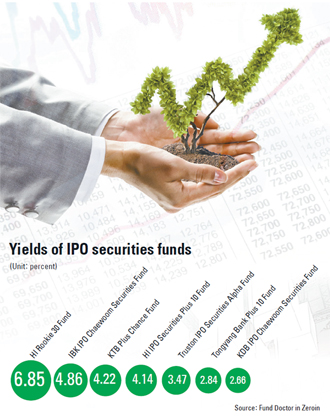Understanding IPO rewards and risks

For the first half of this year, average subscription competition was 779 to 1, meaning than only one in 779 subscribers actually received stock.
In May, when BGF Retail opened bidding, about 4.6 trillion won ($4.2 billion) was invested, the largest IPO since Samsung Life Insurance attracted 4.8 trillion won in 2010.
Samsung SDS and Cheil Industries, large unlisted companies, have announced IPOs and raised expectations of more investment in such stocks.
Earlier this year, the government’s financial team, led by Finance Minister Choi Kyung-hwan, decided to provide a tax incentive to buyers of high-yield funds.
However, it is difficult to expect high returns by blindly jumping on the bandwagon when such stocks are frequently at their peak.
There are three ways to invest in initial public offering stocks: apply for subscription, invest in IPO stocks and invest in high-yield funds that are separated for taxation.
Subscribing for IPO stocks is the direct method, but it is difficult for retail investors to get enough stock.
A 38-year-old employee decided to subscribe for stock in the public offering of Cuckoo Electronics in July after he heard it would make him a fortune.
The employee paid 8 million won he had saved for his wedding as a down payment.
Subscription competition was 175 to 1. He was given only eight shares. On the first day of the IPO, Cuckoo Electronics’ stock surged 9 percent to 100,400 won.
The soon-to-be husband got 820,000 won when he sold the shares shortly after the IPO, which was much less than he expected.
It is natural that retail investors are able to buy only a few IPO stocks, because 60 to 80 percent of shares are allocated to institutional investors first. Retail investors are usually given only about 20 percent.
Before subscribing for IPO stocks, retail investors should know that they don’t always bring them fortunes. Samsung Life Insurance’s public offering caused a national sensation, but its stock soon tumbled below the 100,000 won share price when it went public. It currently remains below that level.
“Before considering investing in IPO stocks, investors should look carefully to see if IPO prices are relatively attractive,” said Oh Seung-hoon, the chief of investment strategy at Daishin Securities. “Look if the PERs (price-to-earnings ratios) of such companies are overestimated compared to other companies in the same industrial sector.”
If subscriptions are too competitive, investors might consider opting for funds that invest in IPO stocks. Funds help individuals share the burdens and costs that accompany direct investments, but they might be less attractive because they tend to have a minimal number of IPO stocks in their portfolios.
Most of them have mixed portfolios with high percentages of bonds. Compared to subscription, the procedure to invest in funds is simpler and investors don’t need a down payment.
According to local fund evaluation agency Zeroin, there are eight funds that produced yields higher than 2.57 percent, the interest rate for deposit savings, so far this year. The average yields of IPO stock investments stood at 50.2 percent in the first half of the year. The reason why IPO stock funds have lower yields than direct investments lies in their unique structure.
“Most days, fund managers invest in bonds to stabilize profits, but they briefly jump into IPO stocks,” said Kim Hu-jeong, a researcher at Tongyang Securities. “Less than 10 percent of the total assets of funds are invested in IPO stocks.”
Investors also might consider high-yield funds that offer tax benefits. Those who invest in such funds will be preferred investors, getting access to IPO stocks earlier than others. But the more the investment, the less attractive the return. High-yield funds have become popular as alternatives to IPO stocks, attracting about 1 trillion won within five months after they were launched.
The government also will give tax benefits for fund investors. Returns of up to 50 million won on high-yield bond funds held for a minimum of one year and a maximum of three will be taxed at 15.4 percent.
But whether those funds are safe needs to be considered, because tax friendly high-yield funds mostly invest in risky bonds graded BBB+ or lower.
“BBB-level corporate bonds are financially risky,” said Oh On-soo, a researcher at Hyundai Securities. “To invest in such funds, it is important to invest for a short time and manage risk.”
BY YEOM JI-HYeoN and SONG SU-HYUN [ssh@joongang.co.kr]










with the Korea JoongAng Daily
To write comments, please log in to one of the accounts.
Standards Board Policy (0/250자)